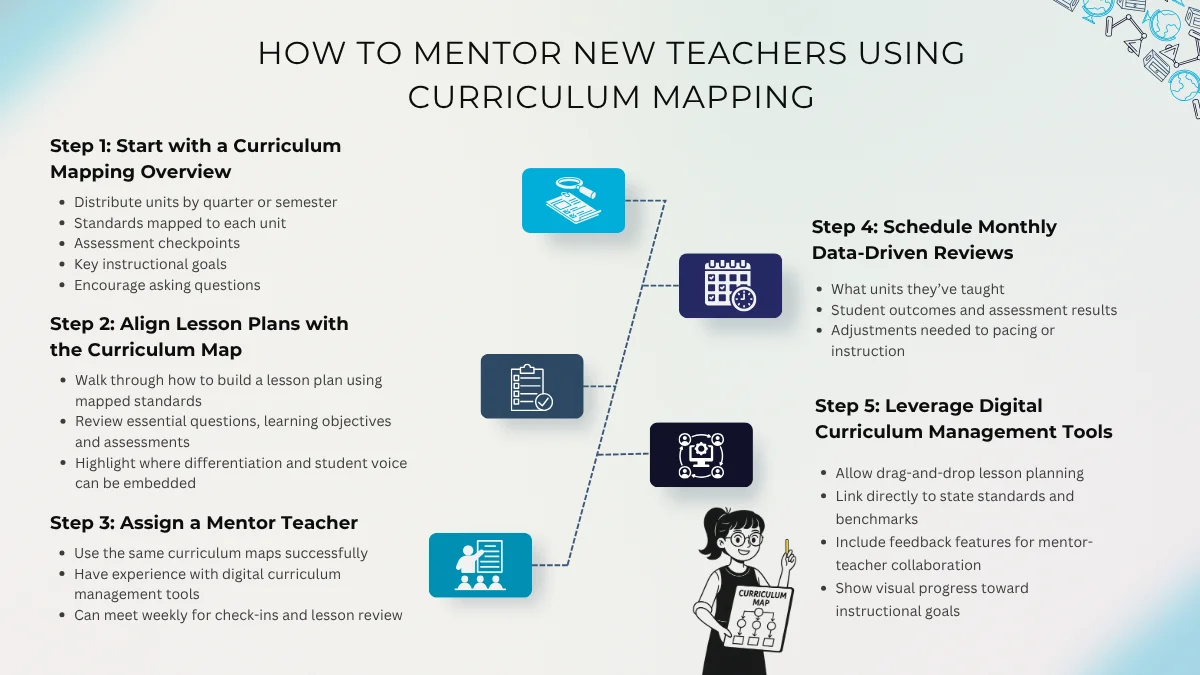Schedule a free demo to learn more
How Can Curriculum Mapping Improve New Teacher Onboarding: A Step-by-Step Onboarding Guide
8th July 2025

Starting a new teaching position is a high-stakes transition. For many educators entering a new school, the learning curve can be steep. They face unfamiliar policies, unknown student needs and an overwhelming amount of content to cover. All of this while trying to build relationships and establish authority in the classroom. While their passion is clear, their path forward often isn’t.
Unfortunately, this lack of structure is more than inconvenient, it’s costly. According to the Learning Policy Institute, schools in the U.S. spend an estimated $8 billion annually on teacher turnover, much of which stems from poor onboarding and lack of instructional support. For school leaders and administrators, the solution lies in a powerful but often underleveraged tool- curriculum mapping.
Read more: The Future of Curriculum Management: Key Insights for Teachers and Instructional Designers
Why Traditional Onboarding Overwhelms New Teachers
Despite the best intentions, many onboarding programs for new teachers are rushed, inconsistent or overly focused on compliance rather than classroom readiness. New educators might receive a brief orientation, a binder of curriculum standards and access to last year’s pacing guides but these don’t offer the clarity needed to confidently plan, teach and assess. A lack of structured onboarding often leads to:
- Disjointed lesson planning and pacing
- Inconsistent instruction across classrooms
- Poor alignment with academic standards
- Increased anxiety and burnout
A RAND Corporation report found that teachers who lack instructional clarity are 2.5 times more likely to leave the profession within the first three years. Hence, the message is clear: teachers don’t just need inspiration, they need a framework.
How Curriculum Mapping Creates Structure and Confidence from Day One
Curriculum mapping offers more than just a bird’s-eye view of standards; it gives teachers the clarity and structure needed to make confident instructional decisions every day. This is especially crucial for new teachers, who often struggle to align lesson plans with district goals or state benchmarks when left to navigate on their own. When implemented well, curriculum maps support:
- Scope and sequence clarity: Teachers know what to teach, when and why.
- Streamlined planning: Educators can focus on student needs instead of constantly recreating plans.
- Standards alignment: Lessons and assessments are designed with outcomes in mind.
- Collaborative consistency: Teachers across classrooms can coordinate instruction, reducing duplication and learning gaps.
A 2023 report by Panorama Education emphasized that structured digital curriculum planning tools help teachers reclaim an average of four hours per week in planning time. That’s nearly 160 hours per school year, the equivalent of a full month of instructional prep saved.
Read more: The ROI of Curriculum Mapping Software: What School Leaders Need to Know in 2025?
Moreover, schools using collaborative curriculum mapping tools report better alignment across grade levels and subjects, which directly contributes to stronger instructional consistency and higher student achievement.
By offering teachers a clear, adaptable framework from day one, curriculum maps eliminate guesswork, reduce burnout and accelerate confidence; particularly for new hires still finding their footing.
A Step-by-Step Guide to Mentoring New Teachers Using Curriculum Mapping
If you’re a school leader, instructional coach or department head, embedding curriculum maps into your teacher onboarding process can transform the experience.

A step-by-step approach to doing it effectively:
Step 1: Start with the Big Picture- The Curriculum Mapping Overview
Before diving into lesson plans, it is prudent to orient new teachers to the entire curriculum map. Explain how it’s structured:
- Units by quarter or semester
- Standards mapped to each unit
- Assessment checkpoints
- Key instructional goals
- Encourage them to ask questions.
This first step builds context, reduces overwhelm and shows how everything fits together. You’re not just handing them a document, you’re giving them a map to navigate their new role.
Step 2: Align Lesson Plans with the Curriculum Map
Once the teacher understands the scope and sequence, the next step is designing lesson plans directly tied to the map. Provide them with school-approved templates and modeling sessions. Ideally, instructional leaders should:
- Walk through how to build a lesson plan using mapped standards
- Review essential questions, learning objectives and assessments
- Highlight where differentiation and student voice can be embedded
This not only accelerates planning but helps teachers stay aligned with both classroom and district-level goals.
Step 3: Assign a Mentor Teacher Familiar with Curriculum Mapping Tools
Every new teacher should have access to a curriculum-savvy mentor. Choose mentors who:
- Use the same curriculum maps successfully
- Have experience with digital curriculum management tools
- Can meet weekly for check-ins and lesson review
Mentorship shouldn’t be passive. It should actively involve reviewing lesson plans, discussing classroom data and sharing teaching strategies within the framework of the curriculum map.
Step 4: Schedule Monthly Data-Driven Reflection and Pacing Reviews
Onboarding isn’t a one-time event. Throughout the school year, create monthly sessions where new teachers reflect on:
- What units they’ve taught
- Student outcomes and assessment results
- Adjustments needed to pacing or instruction
Support them in using the curriculum management platform to update their progress, align upcoming lessons and identify support gaps.
Step 5: Leverage Digital Curriculum Management Tools
Paper-based maps and binders have limitations. Instead, give new teachers access to user-friendly, digital curriculum management tools that:
- Allow drag-and-drop lesson planning
- Link directly to state standards and benchmarks
- Include feedback features for mentor-teacher collaboration
- Show visual progress toward instructional goals
A research from the Digital Promise Institute shows that teachers who use integrated digital tools report 30% higher planning efficiency and 21% greater alignment with state standards.
How Edusfere transforms Teacher Onboarding through Curriculum Mapping
At Edusfere, we understand the chaos that often accompanies new teacher onboarding. That’s why we’ve built our platform to simplify every part of the process, from curriculum overview to daily lesson planning. With Edusfere, school leaders can:
- Share visual curriculum maps tailored to each grade and subject
- Offer structured lesson plan templates linked to standards
- Enable feedback from mentors and coaches
- Track implementation and instructional alignment with curriculum dashboards
Whether you’re onboarding one teacher or many at a time, Edusfere ensures every educator starts with confidence, clarity and the tools they need to succeed.
Why this matters for Principals and School Leaders
An investment in structured onboarding is an investment in teacher retention, student outcomes, and instructional quality. By embedding curriculum mapping into your induction programs, you:
- Reduce instructional guesswork
- Create consistent learning experiences across classrooms
- Improve early-career teacher retention rates
- Ensure all instruction is standards-aligned from day one
Your school doesn’t just need more teachers, it needs better onboarding systems. Systems that support teachers from their first week to their first successful school year.
Ready to Redefine Onboarding in Your School?
Curriculum maps shouldn’t live in dusty binders; they should guide every lesson, every teacher, every day. With Edusfere’s intuitive curriculum management and lesson plan tools, new educators don’t just adapt. They thrive.
Schedule a demo today to see how Edusfere can help your teachers hit the ground running.